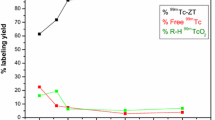Abstract
Paroxetine (a selective serotonin reuptake inhibitor) was successfully labeled with 125I via direct electrophilic substitution reaction at ambient temperature. The reaction parameters studied were paroxetine amount, CAT amount, pH of the reaction mixture, reaction temperature, reaction time and in vitro stability of 125I-paroxetine. 125I-paroxetine was obtained with a maximum labeling yield of 94 ± 0.23% and in vitro stability up to 24 h. Biodistribution studies showed that maximum in vivo uptake of 125I-paroxetine in lungs was 27.89 ± 1.03% injected activity/g tissue at 15 min post-injection and retention in lungs remained high up to 1 h, whereas the clearance from mice appeared to proceed mainly via the hepatobiliary pathway. 125I-paroxetine is not a blood product and so it is more safe than the currently available 99mTc-macroaggregated albumin (99mTc-MAA), and its lung uptake is higher than that of the recently discovered 99mTc(CO)5I and 99mTc-DHPM. As a conclusion, radioiodinated paroxetine could be used as a novel radiopharmaceutical for lung perfusion scan safer than the currently available 99mTc-MAA and more potential than the recently discovered 99mTc(CO)5I and 99mTc-DHPM.








Similar content being viewed by others
References
Christian JA, Partridge M, Nioutsikou E, Cook G, McNair HA, Cronin B, Courbon F, Bedford JL, Brada M (2005) Radiother Oncol 77(3):271–277
Pettersson H, Schulthess GK, Allison DJ, Carty H, Resnick D, Baert AL, Smith HJ, Boutin RD, Andersson I, Grenier P, Ringertz H, Coakley F, Hricak H, Higgins CB, Hermans R, Scotti G (1998) Encycl Med Imaging 1:343
Miniati M, Pistolesi M, Marini C, Ricco GD, Formichi B, Prediletto R, Allescia G, Tonelli L, Sostman HD, Giuntini C (1996) Am J Respir Crit Care Med 154:1387–1393
Tommaso B, Oboldi D, Pier LG, Francesca RM, Paola R, Gabriella N, Giampaolo G (2008) Investig Radiol 43:368–373
Klaus Z, Claudia BS, Jörg P, Joachim K (2009) Ann Nucl Med 23:1–16
Vijayvergiya R, Mittal BR, Grover A, Hariram V, Bhattacharya A, Singh B (2009) Int J Cardiol 20:133
Miroslavov AE, Gorshkov NI, Lumpov AL, Yalfimov AN, Suglobov DN, Ellis BL, Braddock R, Smith AM, Prescott MC, Lawson RS, Sharma HL (2009) Nucl Med Biol 36:73–79
De K, Chandra S, Sarkar B, Ganguly S, Misra M (2010) J Radioanal Nucl Chem 283:621–628
Suhara T, Sudo Y, Yoshida K, Okubo Y, Fukuda H, Obata T, Yoshikawa K, Suzuki K, Sasaki Y (1998) Lancet 351:332–335
Katzman MA (2009) CNS Drugs 23(2):103–120
Baldwin DS, Anderson IM, Nutt DJ, Bandelow B, Bond A, Davidson JR, Boer JA, Fineberg NA, Knapp M, Scott J, Wittchen HU (2005) J Psychopharmacol 19:567–596
Baldwin D, Bobes J, Stein DJ, Scharwachter I, Faure M (1999) Br J Psychiatry 175:120–126
Greenwood N, Earnshaw A (1997) Chemistry of the elements, 2nd edn. Butterworth Heinemann, Oxford
Liu FEI, Youfeng HE, Luo Z (2004) Technical Reports Series No. 426. IAEA, Vienna, pp 37–52
Rhodes BA (1974) J Nucl Med 4:281
Adam MJ, Wilbur DS (2005) Chem Soc Rev 34:153–163
El-Azony KM (2010) J Radioanal Nucl Chem 285:315–320
Tolmachev V, Bruskin A, Sivaev I, Lundqvist H, Sjöberg S (2002) Radiochim Acta 90:229
Puttaswamy M, Sukhdev A, Shubha JP (2009) J Mol Catal A Chem 310:24
Puttaswamy M, Vaz N (2003) Transit Met Chem 28(4):409–417
Ramalingaiah H, Jagadeesh RV, Puttaswamy M (2007) J Mol Catal A Chem 265:70
Motaleb MA, Moustapha ME, Ibrahim IT (2011) J Radioanal Nucl Chem 289:239–245
Henderson RF, Bechtold WE, Medinsky MA, Fischer J, Lee TT (1988) Toxicol Appl Pharmacol 95(5):15–52
Author information
Authors and Affiliations
Corresponding author
Rights and permissions
About this article
Cite this article
Motaleb, M.A., El-Kolaly, M.T., Rashed, H.M. et al. Radioiodinated paroxetine, a novel potential radiopharmaceutical for lung perfusion scan. J Radioanal Nucl Chem 292, 629–635 (2012). https://doi.org/10.1007/s10967-011-1499-7
Received:
Published:
Issue Date:
DOI: https://doi.org/10.1007/s10967-011-1499-7




